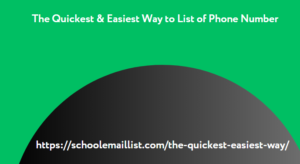In today’s fast-paced digital world, email has become the cornerstone of professional communication. Whether you’re reaching out for a job opportunity, trying to secure a business deal, or simply connecting with colleagues, sending an email is often the first step. However, what happens when you don’t get a response? How do you effectively follow up without being pushy or annoying? Here’s a guide to mastering the art of email follow-ups.
1. Crafting Your Initial Email: The Foundation of Follow-Up Success
Before diving into the nuances of follow-ups, it’s crucial to start with a well-crafted initial email. Here are key pointers:
- Clear and Concise Subject Line: Ensure your subject line is direct and informative. It should give the recipient a clear idea of what the email is about.
- Personalization: Address the recipient by their name and personalize the content based on your relationship or previous interactions.
- Clarity of Purpose: Clearly state the purpose of The Quickest & Easiest Way to List of Phone Number your email in the first few sentences. Whether you’re requesting information, proposing a meeting, or making an introduction, clarity reduces ambiguity.
2. When to Follow Up: Timing Is Everything
Following up at the right time can significantly impact your find landline no response rate. Consider these factors:
- Wait Patiently: Give the recipient enough time to respond before following up. Typically, waiting 3-5 business days is reasonable for most situations.
- Consider Urgency: If your email pertains to time-sensitive matters, adjust your follow-up timeline accordingly. Expressing urgency respectfully can underscore the importance of your message.
- Use Email Tracking Tools: Tools like read receipts or email open tracking can provide insights into whether your email has been viewed, helping you gauge appropriate follow-up timing.
3. Crafting the Follow-Up Email: Polite Persistence Pays Off
Crafting an effective follow-up email requires a balance of persistence and professionalism:
- Friendly Reminder: Start with a polite acknowledgment of your previous email. A simple, “I hope this message finds you well. I wanted to follow up on my previous email regarding…”
- Reiterate Key Points: Summarize the main points of your initial email briefly. This helps jog the recipient’s memory and provides context.
- Offer Additional Information: If relevant, offer additional information or clarify any points from your previous email. This demonstrates your commitment and willingness to provide necessary details.
- Call to Action: End with a clear call to action. Whether it’s a request for a response, a meeting confirmation, or next steps, clarity encourages prompt action.
Conclusion
Mastering the art of email follow-ups is essential for effective communication in professional settings. By crafting clear, concise initial emails and timing your follow-ups appropriately, you increase your chances of receiving a positive response. Remember, persistence with professionalism is key to achieving your communication goals via email.
By implementing these strategies, you can navigate the delicate balance of follow-up etiquette, ensuring your emails are both impactful and respectful of the recipient’s time and priorities.
